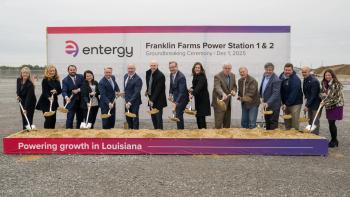
Wind power for the whole world
To supply 100 percent of the present world energy consumption from all fuels we would need four wind farms in the “Roaring Forties” each about 565-km (350 miles) square.
The Roaring Forties is the name given to a band encircling the earth from around 35 – 60 degrees south. This band covers a north-to-south distance on the sea of 2700 km (1700 miles). The wind in this band is higher and more constant than anywhere else on earth. Therefore fewer and smaller turbines could be used.
The U.S. annual consumption recently approached 100 quads in 2007, which is approximately
10^20 J/year, from all sources. World consumption, also from all sources, is generally
reckoned to be about four times this amount. Data are imprecise, and the following
calculations are also general and imprecise.
G.E. is among several companies making 5-MW wind turbines, and it is planning 7-MW versions. A group in Norway is producing high-wind off-shore turbines, having a smaller diameter and more-robust turbine blades than those designed for temperate-wind areas. Wind turbines are generally spaced four diameters apart. This would mean a spacing of 400m for 5-MW high-wind turbines. Siemens has introduced a 6MW turbine.
Two possibilities are to mount two turbines at opposite ends of 400-m-long concrete
barges (the length of supertankers); and, alternatively, to mount each turbine on an
individual concrete “floater”, probably in the form of a long (deep) cylinder that would
not respond to surface waves. Each alternative would be anchored by cables to concrete masses on the sea-bed. (Prof. Paul Sclavounas of M.I.T. and the U.S. National Renewable Energy Lab. have worked on this second concept and consider it feasible.)
The proposed wind farms would be too far from energy markets to use undersea electric cables. The US National Renewable Energy Lab (NREL) has announced the
development of
.The hydrogen (and probably the
oxygen also) could be shipped by supertankers to major markets around the world. Or
the supertankers could take liquefied carbon dioxide to the wind farms on the outward voyage so that a liquid fuel such as alcohol could be produced on site and shipped back. There are many other alternatives that could be explored.
Let us assume pessimistically that the average output of a 5-MW turbine in the Roaring Forties would be 3 MW. We will also pessimistically specify that only half this energy output reaches markets in the U.S., Europe, China and Japan (even though a modern LNG supertanker typically uses only 2% of its cargo in a round-trip voyage.) Therefore each turbine on average is responsible for a delivery of 1.5 MW year-round.
Only two million turbines would be required to supply all US nonrenewable energy. If arranged in a square there would be 1415 turbines spaced 400-m apart in 1415 rows, which would be a 565-km (350-miles) square farm. Four of these wind farms would supply the whole world with renewable energy and could stop global warming from energy use. The space occupied by these four wind farms would be a tiny proportion of the Roaring Forties, which total around 50-million square kilometers.
The proposal above is an example of “reduction ad absurdum”. The purpose is to show that current whining about the impossibility of replacing petroleum with renewable energy is hogwash. Harvesting this energy would appear to do no harm to anyone or any wildlife. The wind is slowed down by friction with the sea in any case, so that the continual storms might produce waves reduced by an insignificant amount. There is little shipping or bird flight in these waters. We in the U.S. might start by building say 2000 turbines, enough to supply one-percent of our current energy usage, to test the concept and to establish costs. These costs would be far less than those for launching another war to protect “our” energy supplies.
A group called Sahara Wind
would like to have wind turbines
along 2000 km of the Sahara desert south of Morocco and close to the Atlantic ocean. It claims that these would generate enough energy to supply half the electricity needs of Europe.
(David Gordon Wilson is emeritus professor of engineering at MIT)
Newsletter
Power your knowledge with the latest in turbine technology, engineering advances, and energy solutions—subscribe to Turbomachinery International today.





